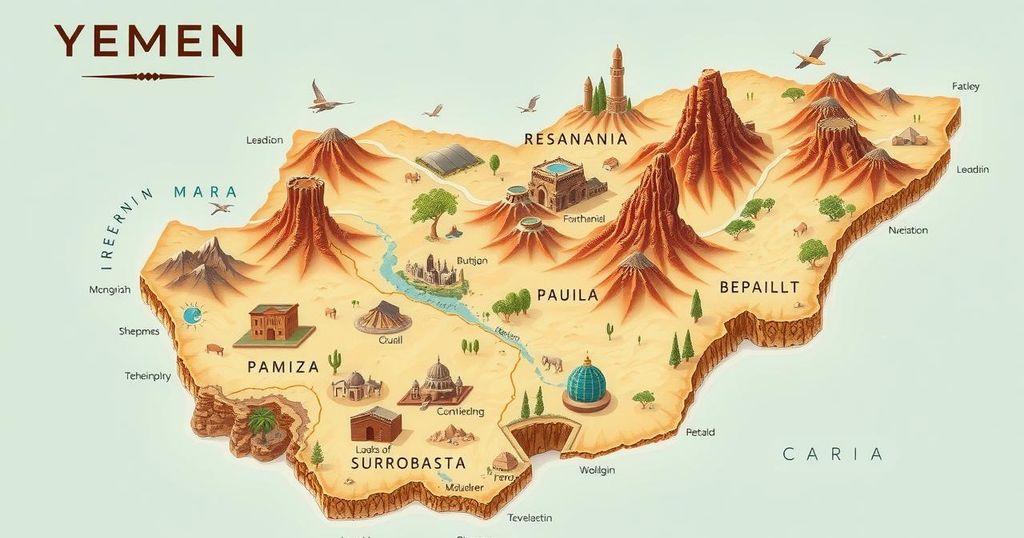The Yemeni Civil War began in 2014 with the Houthi takeover of Sanaa, compounded by Saudi and UAE interventions leading to widespread famine and a cholera outbreak. Ali Abdullah Saleh’s historical leadership set the stage for the conflict, witnessing protests and a transitional government failing to stabilize the nation. By 2023, rising Houthi aggressions towards Israel marked a new concerning phase in a war that has devastated Yemen and continues to draw international focus and intervention efforts.
The Yemeni Civil War, which commenced in 2014, is a catastrophic conflict originating from the Houthi takeover of the capital, Sanaa, amidst the aftermath of the Arab Spring. The engagement of Saudi Arabia and the United Arab Emirates escalated the crisis, bringing the nation to the brink of famine and contributing to an unprecedented cholera outbreak. By 2020, Houthi forces seemed to gain momentum, particularly as foreign military presence waned, leading to a complex new phase of conflict by 2023, with attacks on Israel and maritime threats following the Israel-Hamas War.
The historical roots of the conflict trace back to Ali Abdullah Saleh, who unified Yemen in the late 1980s under challenging conditions. His inadequately addressed Zaydī Shiʿi grievances set the stage for the emergence of the Houthi movement. Saleh faced incessant pressures from various factions throughout his rule, which lasted over three decades, resulting in deep societal fissures that further ignited unrest post-2011.
Inspired by the Arab Spring uprisings, thousands of Yemenis protested against Saleh’s regime in early 2011, driven by demands for democracy and fueled by widespread poverty and corruption. The opposition consisted of a diverse array of groups, including the Houthis, southern secessionists, and Sunni Islamists, contributing to a chaotic political landscape that saw violent clashes even amidst failed attempts at concessions from Saleh.
As unrest spread and government control waned, the Houthi rebellion gathered strength, particularly in the north. Tensions escalated between loyalist forces and various opposition groups, culminating in an uneasy power transfer to Vice President Abd Rabbuh Mansur Hadi following Saleh’s exit. Nonetheless, the country’s challenges persisted, and ongoing discontent led to renewed Houthi aggression, which peaked with their capture of Sanaa in 2014.
Following Hadi’s resurgence in Aden in early 2015, Saudi-led intervention began, aiming to retract Houthi advances. Despite achieving some successes, such as the reclaiming of Aden, dislodging Houthi forces from the north proved to be extremely difficult, resulting in soaring civilian casualties and infrastructural devastation as fighting evolved into a humanitarian crisis.
The conflict further deteriorated, leading to severe famine and the world’s largest cholera outbreak by 2016, as no resolution was attained amid ongoing hostilities. With the assassination of Saleh in December 2017 by Houthi forces, the situation evolved, with the southern secessionists gaining traction against Hadi’s government, leading to further complications in the coalition.
In 2018, the coalition’s attempt to capture Hodeidah highlighted the ongoing battle for resources and control. A fragile UN-brokered ceasefire prompted hope yet was marred by accusations of misconduct from both sides. Through 2019, fighting persisted, compounded by the COVID-19 pandemic, which shifted dynamics as both sides recalibrated their strategies amidst changing global conditions.
In subsequent years, Houthi rebels continued to besiege strategic locations, such as Maʾrib, while intermittently engaging in negotiations that yielded temporary ceasefires. By 2023, however, the geopolitical landscape shifted with escalating Houthi aggression toward Israel, demonstrating their aim for regional influence despite the backdrop of a protracted internal struggle.
Recent developments, notably the Hamas attack on Israel, further complicated the situation, prompting the Houthis to assert military actions against Israeli targets and commercial vessels in the Red Sea, consequently drawing the attention and military responses from the United States and allied forces against the Houthi militancy.
The Yemeni Civil War underscores the complexities surrounding regional politics, sectarian divisions, and humanitarian crises. Since its initiation in 2014, the conflict has evolved dramatically, involving external interventions and resulting in devastating consequences for the Yemeni populace. As Houthi insurgents assert themselves more aggressively in the regional theatre, the situation remains precarious, with international actors increasingly involved in efforts to quell hostilities and navigate the multifaceted conflicts that define Yemen’s ongoing struggle for stability.
Original Source: www.britannica.com




